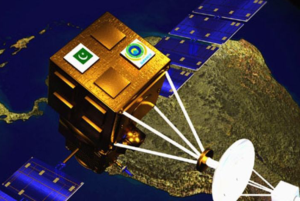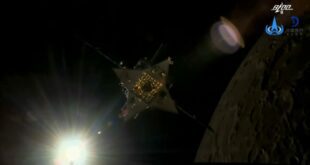
The Chinese state news outlet Xinhua has reported that the Pakistan Remote Sensing Satellite (PRSS)-1 and PakTES-1A will be launched in June 2018 from the Taiyuan Satellite Launch Centre using a Long March-2C/SMA space launch vehicle.
As of the publication of this report no exact date in June was provided by the China Academy of Launch Vehicle Technology (CALVT) who made the announcement on 3 April 2018 on their website.
The PRSS-1 is to be Pakistan’s first operational earth observation satellite, with its main role supporting Pakistan’s economic development, monitoring geological and environmental phenomena, and providing support for disaster relief and monitoring areas of interest to the China Pakistan Economic Corridor (CPEC), perhaps the single most important project in China’s Belt and Road Initiative (BRI).
The chairman of Pakistan’s space agency, the Space and Upper Atmospheric Research Commission (SUPARCO), Qaiser Anees Khurram, told the UAE’s Gulf News in 2017 that PRSS-1 “will make Pakistan self-reliant in multi-spectral imaging.” Pakistani officials also hope that PRSS-1 will provide a measure of strategic autonomy in Earth observation for Islamabad by reducing Pakistani reliance on foreign and commercial satellite imagery.
Dr. Khurram also said in 2017 that, “Our first optical remote sensing satellite is all set to be launched in 2018…Pakistan Remote Sensing Satellite (PRSS-1) will make Pakistan self-reliant in multi-spectral imaging. Remote sensing satellite will have multiple benefits and practical applications, including agriculture, disaster management, urban planning, forestry, water management, weather forecast and other areas.”
SUPARCO signed a development and launch agreement for the PRSS-1 with China Great Wall Industry Cooperation (CGWIC) in April 2016. Ahsan Iqbal, the then Pakistani Planning, Development, and Reform Minister, told news outlets at the time that the contract would involve the transfer of space technology to Pakistan. Iqbal had also alluded that the PRSS-1 would contribute to Pakistan’s national security interests, particularly for border security and surveillance.
PRSS-1 has been built by Chinese satellite manufacturer China Academy of Space Technology (CAST), and China Great Wall Industries Corporation will launch the satellite on board a Long March-2C launch vehicle. PRSS-1 was origionally slated to be launched in 2016, then March 2018, and now June 2018. Neither SUPARCO, CGWIC, or CALVT have provided any explanation for these delays.
PakTES-1A will also be launched with PRSS-1, and is believed to be a test and evaluation satellite that will carry an Earth observation sensor. PakTES-1A was built by SUPARCO, with assistance from South African satellite manufacturer Space Advisory Company (SAC), for an estimated budget of U.S.$9.5 million.
PakTES-1A is thought to have a mass of 300 kilograms and has been designed, developed, assembled, integrated, and tested by SUPARCO engineers in Pakistan. According to a document seen by SpaceWatch.Global SUPARCO had originally sought to procure the EO camera and mirrors from within Pakistan but found that there was a lack of technical capacity. SUPARCO then looked to Chinese companies and agencies, according to the document, but the bids it received were too expensive and would have required a bigger satellite. It was only after this that SUPARCO sought out CapeTown-headquartered SAC.
SpaceWatch.Global reached out to SAC about their participation in the PakTES-1A programme, but had not received any comment from the South African company by the time of publication deadline.





